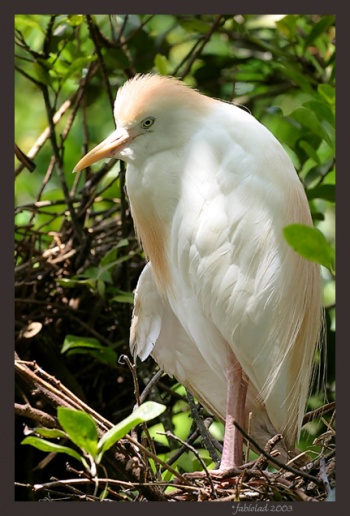| Line 1: | Line 1: | ||
;Bubulcus ibis | ;Bubulcus ibis | ||
[[Image:Cattle_Egret.jpg|thumb|350px|right|Breeding Plummage]] | [[Image:Cattle_Egret.jpg|thumb|350px|right|Breeding Plummage]] | ||
| − | |||
| − | |||
==Distribution== | ==Distribution== | ||
Almost cosmopolitan. Occurs widely in sub-Saharan Africa from Senegal to Sudan and south to South Africa including Madagascar and the Seychelles. Also breeds in north-west Africa, Iberia and parts of southern France. Has recently has begun breeding in the Canary Islands, western, central and northern France, Belgium, on Sardinia and around the eastern Mediterranean in Turkey, the Middle East and Egypt. Small numbers breed in the Volga Delta of Russia. In Asia breeds throughout the Indian Subcontinent east to China and southern Japan and south to Indonesia, New Guinea and throughout Australia except the most arid interior. Also widespread in the Americas. In North America occurs from south-east Canada south to Florida and the Gulf Coast and in the west breeds in California and Utah and regularly occurs north to British Columbia during post-breeding dispersal. Found throughout Mexico, Central America and the West Indies and in South America extends south to northern Argentina. Many populations are dispersive and undergo rather random movements, while others are more strongly migratory. Recorded as a vagrant in most European countries where not regular, north to Iceland, Scandinavia and Poland, and also in the Azores, Madeira and the Canary Islands but some reports may involve escapes. British records, (c.120), widely scattered from Sicilly north to Shetland and throughout the year. Has bred in the Canaries and Cape Verde Islands and the first breeding for the Baleares was recorded on Mallorca in 1997. | Almost cosmopolitan. Occurs widely in sub-Saharan Africa from Senegal to Sudan and south to South Africa including Madagascar and the Seychelles. Also breeds in north-west Africa, Iberia and parts of southern France. Has recently has begun breeding in the Canary Islands, western, central and northern France, Belgium, on Sardinia and around the eastern Mediterranean in Turkey, the Middle East and Egypt. Small numbers breed in the Volga Delta of Russia. In Asia breeds throughout the Indian Subcontinent east to China and southern Japan and south to Indonesia, New Guinea and throughout Australia except the most arid interior. Also widespread in the Americas. In North America occurs from south-east Canada south to Florida and the Gulf Coast and in the west breeds in California and Utah and regularly occurs north to British Columbia during post-breeding dispersal. Found throughout Mexico, Central America and the West Indies and in South America extends south to northern Argentina. Many populations are dispersive and undergo rather random movements, while others are more strongly migratory. Recorded as a vagrant in most European countries where not regular, north to Iceland, Scandinavia and Poland, and also in the Azores, Madeira and the Canary Islands but some reports may involve escapes. British records, (c.120), widely scattered from Sicilly north to Shetland and throughout the year. Has bred in the Canaries and Cape Verde Islands and the first breeding for the Baleares was recorded on Mallorca in 1997. | ||
Revision as of 15:14, 10 June 2007
- Bubulcus ibis
Distribution
Almost cosmopolitan. Occurs widely in sub-Saharan Africa from Senegal to Sudan and south to South Africa including Madagascar and the Seychelles. Also breeds in north-west Africa, Iberia and parts of southern France. Has recently has begun breeding in the Canary Islands, western, central and northern France, Belgium, on Sardinia and around the eastern Mediterranean in Turkey, the Middle East and Egypt. Small numbers breed in the Volga Delta of Russia. In Asia breeds throughout the Indian Subcontinent east to China and southern Japan and south to Indonesia, New Guinea and throughout Australia except the most arid interior. Also widespread in the Americas. In North America occurs from south-east Canada south to Florida and the Gulf Coast and in the west breeds in California and Utah and regularly occurs north to British Columbia during post-breeding dispersal. Found throughout Mexico, Central America and the West Indies and in South America extends south to northern Argentina. Many populations are dispersive and undergo rather random movements, while others are more strongly migratory. Recorded as a vagrant in most European countries where not regular, north to Iceland, Scandinavia and Poland, and also in the Azores, Madeira and the Canary Islands but some reports may involve escapes. British records, (c.120), widely scattered from Sicilly north to Shetland and throughout the year. Has bred in the Canaries and Cape Verde Islands and the first breeding for the Baleares was recorded on Mallorca in 1997.
Habitat
Freshwater margins and open grasslands. Often associates with cattle and other livestock; and also wild ungulates, frequently close to human habitation. Breeds colonially in trees, usually close to water but often seen far from water at other seasons.
Identification
The Cattle Egret is a stocky species, averaging 51 cm long and weighing 340 - 390 g, with a short thick bill. The non-breeding adult has all-white plumage, a yellow bill, and greyish-yellow legs. When breeding, orange buff plumes develop on the back, breast and crown, and the legs become orange pink. The sexes are similar, but juvenile birds have a black bill. ==Subspecies==Nominate race is found over most of range. Race coromandus with stronger golden breeding plumage occurs in southern Asia and intermediate race seychellarum is found in the Seychelles.
Diet
The Cattle Egret’s feeding grounds are usually under 20km from roost site. Typically hunts by walking steadily and stabbing at prey. It feeds on insects, especially grasshoppers, locusts and beetles.
Reproduction
Colonial nester, usually with other waterbirds. Nest are built from collected or stolen (from other nests) dry sticks, weed stems and reeds; occasionally lined with grass.
Bird Song
<flashmp3>Bubulcus ibis (song).mp3</flashmp3>
Listen in an external program




